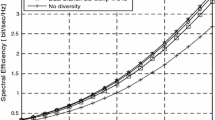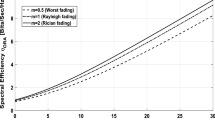Abstract
The performance of the double-antenna switched diversity combining (SDC) system over N-Nakagami fading channels is investigated in this paper. Based on the method of the probability density function of the signal-to-noise ratio, the exact expressions for the channel capacity and average symbol error probability (ASEP) are derived. Then the channel capacity and ASEP performance under different conditions is evaluated through numerical simulations to verify the analysis. The simulation results showed that the performance of the double-antenna SDC system is improved with the fading coefficient increased, but the level of improvement is declined as the number of cascaded components increased.




Similar content being viewed by others
References
G. Wu, S. Talwar, K. Johnsson, N. Himayat and K. D. Johnson, M2M: from mobile to embedded internet, IEEE Communications Magazine, Vol. 49, No. 4, pp. 36–43, 2011.
M. Jo, T. Maksymyuk, B. Strykhalyuk and C. H. Cho, Device-to-device based heterogeneous radio access network architecture for mobile cloud computing, IEEE Wireless Communications, Vol. 22, No. 3, pp. 50–58, 2015.
S. Mumtaz, K. M. S. Huq and J. Rodriguez, Direct mobile-to-mobile communication: paradigm for 5G, IEEE Wireless Communications, Vol. 21, No. 5, pp. 14–23, 2014.
B. Talha and M. Patzold, Channel models for mobile-to-mobile cooperative communication systems: a state of the art review, IEEE Vehicular Technology Magazine, Vol. 6, No. 5, pp. 33–43, 2011.
J. Salo, H. E. Sallabi and P. Vainikainen, Statistical analysis of the multiple scattering radio channel, IEEE Transactions on Antennas and Propagation, Vol. 54, No. 11, pp. 3114–3124, 2006.
J. Salo, H. E. Sallabi and P. Vainikainen, The distribution of the product of independent Rayleigh random variables, IEEE Transactions on Antennas and Propagation, Vol. 54, No. 2, pp. 639–643, 2006.
M. Uysal, Diversity analysis of space-time coding in cascaded Rayleigh fading channels, IEEE Communications Letters, Vol. 10, No. 3, pp. 165–167, 2006.
G. K. Karagiannidis, N. C. Sagias and P. T. Mathiopoulos, N*Nakagami: a novel stochastic model for cascaded fading channels, IEEE Transactions on Communications, Vol. 55, No. 8, pp. 1453–1458, 2007.
F. K. Gong, P. Ye, Y. Wang and N. Zhang, Cooperative mobile-to-mobile communications over double Nakagami-m fading channels, IET Communications, Vol. 6, No. 18, pp. 3165–3175, 2012.
Z. X. Fang, X. Yuan and X. Wang, Towards the asymptotic sum capacity of the MIMO cellular two-way relay channel, IEEE Transactions on Signal Processing, Vol. 62, No. 6, pp. 4039–4051, 2014.
L. Xiao and X. Dong, New results on the BER of switched diversity combining over Nakagami fading channels, IEEE Communications Letters, Vol. 9, No. 2, pp. 136–138, 2005.
D. M. Jiménez, J. F. Paris and K. K. Wong, Closed-form analysis of multibranch switched diversity with noncoherent and differentially coherent detection, International Journal of Communication Systems, Vol. 26, No. 1, pp. 127–137, 2013.
S. Khatalin, Performance analysis of switch and stay combining diversity system over κ-μ fading channels, International Journal of Electronics and Communications, Vol. 69, No. 2, pp. 475–486, 2015.
L. Z. Xun, C. W. Kui, L. Bo and H. H. Ying, On the performance of maximal-ratio-combining over double-Rayleigh fading channels, Journal of Circuits and Systems, Vol. 17, No. 3, pp. 88–93, 2012.
W. Wongtraitrat and P. Supnithi, Performance of digital modulation in double Nakagami-m fading channels with MRC diversity, IEICE Transactions on Communications, Vol. E92B, No. 2, pp. 559–566, 2009.
J. Malhotra, A. K. Sharma and R. S. Kaler, On the performance of wireless receiver in cascaded fading channel, African Journal of Information & Communication Technology, Vol. 1, No. 4, pp. 65–72, 2008.
Z. Shuang, Y. W. Bin, Y. H. Wen and W. Y. Feng, Ergodic capacity of switch-and-examine combining under flat Rayleigh fading channels, Journal of China Universities of Posts and Telecommunications, Vol. 16, No. 1, pp. 44–46, 2009.
M. K. Simon and M. S. Alouini, Digital Communication over Fading Channels, vol. 2nd, WileyNew York, 2004.
V. S. Adamchik and O. I. Marichev, The algorithm for calculating integrals of hypergeometric type functions and its realization in reduce system, Proceedings of International Symposium on Symbolic and Algebraic ComputationTokyo, Japan, 1990.
“The Wolfram functions site.” [Online]. Available: http://functions.wolfram.com.
Acknowledgments
The authors would like to thank the referees and editors for providing very helpful comments and suggestions. This project was supported by National Natural Science Foundation of China (Nos. 61304222, 60902005), Natural Science Foundation of Shandong Province (No. ZR2012FQ021), Shandong Province Higher Educational Science and Technology Program (No. J12LN88).
Author information
Authors and Affiliations
Corresponding author
Rights and permissions
About this article
Cite this article
Xu, L., Zhang, H., Wang, J. et al. Performance Analysis of the Double-Antenna SDC System Over N-Nakagami Fading Channels. Int J Wireless Inf Networks 23, 49–56 (2016). https://doi.org/10.1007/s10776-016-0296-1
Received:
Accepted:
Published:
Issue Date:
DOI: https://doi.org/10.1007/s10776-016-0296-1




